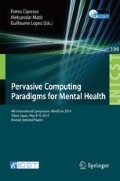Abstract
Children afflicted with developmental disabilities, namely autism, suffer from a natural aversion to dyadic (i.e., eye-to-eye) contact. Research has shown this aversion to be an early indicator of slower development of linguistic skills, a narrow vocabulary, as well as social issues later in life. In addition, this aversion may also result in the loss of already acquired abilities such as language and life skills. Consequently, manual prompt techniques have been adopted to address this issue. However, they are plagued with some inherent flaws: (i) the teacher must make unnatural movements when using a manual prompt such as gesturing towards the face; (ii) The child’s attention will follow this prompt as it is removed from the face defeating the purpose as it detracts the child’s attention from the teacher’s eyes. To tackle these issues we have developed a system that can utilize effective prompt methodologies aimed at conditioning these children to establish and maintain dyadic contact. Our system not only reduces, but eliminates shortcomings present in the current manual method. This is accomplished through the use of a stereo camera and virtual reality headset to augment the child’s vision when eye contact is not being established. The prompt is displayed in the child’s vision over the eyes of the teacher to attract their attention. Once dyadic contact has been ascertained, the prompt is gradually fading leaving the child only to focus on the eyes of the teacher as is needed.
Access this chapter
Tax calculation will be finalised at checkout
Purchases are for personal use only
References
Wimpory, D.C., Hobson, R.P., Williams, M.G., Nash, S.: Are infants with autism socially engaged? A study of recent retrospective parental reports. J. Autism Dev. Disord. 30, 525–536 (2000)
Woods, J.J., Wetherby, A.M.: Early identification of and intervention for infants and toddlers who are at risk for autism spectrum disorder. Lang. Speech Hear. Serv. Schools 34, 180–193 (2003)
Mirenda, P., Donnellan, A., Yoder, D.: Gaze behavior: a new look at an old problem. J. Autism Dev. Disord. 13, 397–409 (1983)
Stern, D.: The Interpersonal World of the Infant. Basic Books, New York (1985)
Tiegerman, E., Primavera, L.H.: Imitating the autistic child: facilitating communicative gaze behavior. J. Autism Dev. Disord. 14, 27–38 (1984)
Lee, K., Eskritt, M., Symons, L.A., Muir, D.: Childrens use of triadic eye gaze information for ‘mind reading’. Dev. Psychol. 34, 525–539 (1998)
Podrouzek, W., Furrow, D.: Preschoolers’ use of eye contact while speaking: the influence of sex, age, and conversational partner. J. Psycholinguist. Res. 17, 89–98 (1988)
Kleinke, C.L.: Gaze and eye contact: a research review. Psychol. Bull. 100(1), 78–100 (1986)
Greer, D.R., Ross, D.E.: Verbal Behavior Analysis. Pearson Education, New York (2007)
Lovaas, O.I.: The Autistic Child: Language Development through Behavior Modification. Irvington, New York (1977)
Lovaas, O.I.: Teaching Developmentally Disabled Children: The Me Book. University Park Press, Baltimore (1981)
Dube, W.V., McIlvane, W.J.: Reduction of stimulus selectivity with nonverbal differential observing responses. J. Appl. Behav. Anal. 32, 25–34 (1999)
Lovaas, O.I., Schreibman, L.: Stimulus overselectivity of autistic children in a two-stimulus situation. Behav. Res. Ther. 9, 305–310 (1971)
Smeets, P.M., Lancioni, G.E., Striefel, S.: Discrimination training through time delay of multistimulus prompts: the shapes and locations of the prompts. Psychol. Rec. 37, 507–521 (1987)
Zygmont, D.M., Lazar, R.M., Dube, W.V., McIlvane, W.J.: Teaching arbitrary matching via sample stimulus-control shaping to young children and mentally retarded individuals: a methodological note. J. Exp. Anal. Behav. 57, 109–117 (1992)
Finkelstein, S.L., Nickel, A., Barnes, T., Suma, E.A.: Astrojumper: designing a virtual reality exergame to motivate children with autism to exercise. 2010 IEEE Presented at the Virtual Reality Conference (VR), pp. 267–268 (2010)
Lahiri, U., Warren, Z., Sarkar, N.: Design of a gaze-sensitive virtual social interactive system for children with autism. IEEE Trans. Neural Syst. Rehabil. Eng. 19(4), 443–452 (2011)
Cai, Y., Chia, N.K.H., Thalmann, D., Kee, N.K.N., Zheng, J., Thalmann, N.M.: Design and development of a virtual dolphinarium for children with autism. IEEE Trans. Neural Syst. Rehabil. Eng. 21(2), 208–217 (2013)
Kandalaft, M., Didehbani, N., Krawczyk, D., Allen, T., Chapman, S.: Virtual reality social cognition training for young adults with high-functioning autism. J. Autism Dev. Disord. 43, 34–44 (2013)
Ferster, C.B., Nurnberger, J.I., Levitt, E.B.: The control of eating. Obes. Res. Clin. Pract. 4, 401–410 (1962)
Lovaas, O.I., Berberich, J.P., Perloff, B.F., Schaeffer, B.: Acquisition of imitative speech by schizophrenic children. Science 151, 705–707 (1966)
Lovaas, O.I., Freitas, L., Nelson, K., Whalen, C.: The establishment of imitation and its use for the development of complex behavior in schizophrenic children. Behav. Res. Ther. 5, 171–181 (1967)
Metz, J.R.: Conditioning generalized imitation in autistic children. J. Exp. Child Psychol. 4, 389–399 (1965)
OpenGL (Open Graphics Library). http://www.opengl.org/
OpenCV (Open Source Computer Vision). http://opencv.org/
Viola, P., Jones, M.: Rapid object detection using a boosted cascade of simple features. In: Proceedings of the IEEE Computer Society Conference on Computer Vision and Pattern Recognition, pp. 511–518 (2001)
Brunelli, R.: Template Matching Techniques in Computer Vision: Theory and Practice. Wiley, Chichester (2009)
Lambooij, M.T.M., IJsselsteijn, W.A., Heynderickx, I.: Visual discomfort in stereoscopic displays: a review. Electronic 64900I–64900I-13 (2007)
Kooi, F.L., Toet, A.: Visual comfort of binocular and 3D displays. Displays 25, 99–108 (2004)
Oculus Rift. http://www.oculusvr.com/
Lacrama, D.L., Fera, D.: Virtual Reality (2009)
Acknowledgments
We would like to thank Dr. Katherine Loveland for helpful discussions and equipment, and Tzu-Hua Liu for giving us helpful pointers to work related to this research.
Author information
Authors and Affiliations
Corresponding author
Editor information
Editors and Affiliations
Rights and permissions
Copyright information
© 2014 Institute for Computer Sciences, Social Informatics and Telecommunications Engineering
About this paper
Cite this paper
Wang, X. et al. (2014). Eye Contact Conditioning in Autistic Children Using Virtual Reality Technology. In: Cipresso, P., Matic, A., Lopez, G. (eds) Pervasive Computing Paradigms for Mental Health. MindCare 2014. Lecture Notes of the Institute for Computer Sciences, Social Informatics and Telecommunications Engineering, vol 100. Springer, Cham. https://doi.org/10.1007/978-3-319-11564-1_9
Download citation
DOI: https://doi.org/10.1007/978-3-319-11564-1_9
Published:
Publisher Name: Springer, Cham
Print ISBN: 978-3-319-11563-4
Online ISBN: 978-3-319-11564-1
eBook Packages: Computer ScienceComputer Science (R0)

